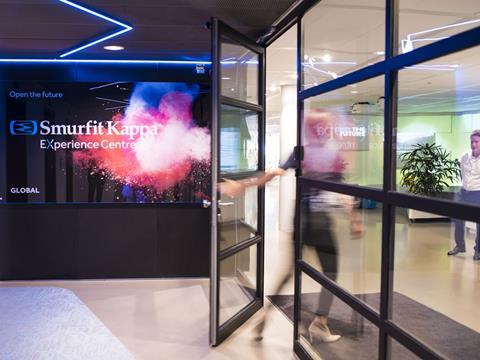
Arco Berkenbosch, Smurfit Kappa’s VP, Innovation and Development, speaks to Libby White and Tim Sykes about the need to factor in realistic end-of-life scenarios when designing packaging for sustainability.
Packaging Europe:
Across the industry it’s well known that packaging benefits the environment by preventing waste and optimising logistics in a resource-efficient manner. But across society there is understandable anxiety about packaging waste, in particular unrecycled waste. How do you view this tension between the positive and negative impacts of packaging?
Arco Berkenbosch:
This tension is a positive thing and it will always exist. The most sustainable packaging is something we can all dream of, but it isn’t a reality that is well defined or fully understood today. You have to find the best compromise between the environmental impact of the packaging, and the added value it can bring to the supply chain.
One of the main challenges for packaging is found at its end of life. I strongly believe that from a packaging design point of view you must tackle the weak points. The added value packaging brings to the supply chain can’t be used as an excuse for the waste or litter packaging might create at end of life. The main problem is when there is an uncontrolled situation at end of life. Packaging designers and innovators must pick up this challenge to solve the problem.
PE:
What concrete actions would this involve at the product development stage?
AB:
Focusing on the sustainability impact, in the development stage of the packaging we must multiply the intended end of life scenario with the chance that it will happen in practice. We have to factor in reality. If the packaging material is compostable, but we know that in general only five per cent of this material ends up in the correct end of life stream, then it is not a sustainable packaging in reality. The probability and significance of this is not considered enough. A sustainable package might still be waste if it ends up next to a highway or in the ocean and stays there for years.
Take the example of recyclability in the paper industry. If a paper-based packaging substrate is made of 85 per cent recyclable material, for example if it has a plastic coating, this in principle sounds good. However, if the other 15 per cent is unrecyclable, in practice the whole product cannot be recycled. Our challenge is to design products in a way that means entering an uncontrolled waste stream is not an option.
A beautiful example of this approach is with soda cans. Remember how in the past the ring pull used to separate from the can after opening? Now it remains connected to the can, which means there is no longer an option that it can be thrown away separately after opening a can, for instance next to a highway.
From an R&D point of view, we need to make packaging fool-proof, so that in actual usage the chance of it ending up in landfill is minimum. And if it ends up as litter, it should biodegrade quickly.
PE:
Are there any examples of integrating these kinds of end of life scenarios into Smurfit Kappa’s R&D?
AB:
An example from Smurfit Kappa comes from our bag-in-box applications. As is well known, there are two types of materials involved in this packaging: the renewable box material and the plastic bag. The connection of these two materials is designed in such a way so they can be easily separated after use and disposed of into the correct waste streams. We combine the strength of the plastic bag for the quality of the wine with the strength of the box for transport and communication to the consumer. In this way we use the unique properties of both materials in an optimal way.
Looking at material combinations, recyclability is a key criterion. Smurfit Kappa’s MB12 is a great example. This is a board solution that provides a barrier to mineral oil migration into food products, but uniquely remains recyclable in the normal waste stream, with no adaptations needed. Traditionally, this has been achieved by a barrier layer which renders it unsuitable for the normal recycling process. We add the functionality without creating any additional burden for the consumers in order to recycle. It remains fully recyclable.
In my opinion packaging developers often underestimate the brief. They look for a solution that requires changes in consumer behaviour but this takes time. We say too lightly that we need to change the consumer behaviour but we as packaging leaders also need to take this on as a design challenge.

PE:
There is of course particularly fierce attention on plastics at the moment, with media and public pressure to reduce or even eliminate their use in packaging. Smurfit Kappa sits in a more comfortable position since it can point to both renewable feedstocks and comparatively high recycling rates of paper-based packaging. What is your perspective on the current debate around plastics?
AB:
The debate brings a problem to the forefront, which at the core is a clear problem for the entire packaging industry. Packaging in itself has no other reason for its existence than to protect, bundle and sell the product inside. When the product life of the packaging is far longer than the product it contains inside, therein lies the complication and problem. We need to consider whether the material will last for ten, twenty, or 100 years into the future, and whether its functionality is needed to exist for so long. Who knows if we still need these materials in 100 years? Take the example of the Colosseum. It served its original purpose but was not needed to withstand time and remain so far into the future. One Colosseum is nice for the tourists but imagine if we had thousands of them!
Of course we have to educate consumers to improve recycling rates and waste handling.
We should aim to design packaging that has the same product life as the product it packages. This is the core of the challenge. It goes deeper than focusing on achieving recyclability or using renewable resources, as we still face the problem of uncontrolled waste streams. For example, paper-based packaging has an extremely high recycling rate of above 80 per cent, but it can still enter uncontrolled waste streams.
So the question we should ask is: how can we develop packaging that causes limited harm to the planet in uncontrolled situations? Paper-based packaging has the clear advantage that it’s biodegradable in many circumstances, such as if it enters the ocean. However, I believe there is a clear role in our society for plastic packaging too, due to its necessary functionality. In many applications of plastic packaging, it is needed for its functional resistance against water, and to prevent liquid leakage. This is an unsolvable contradiction: you can’t have a package that protects against leakage of liquids and provides moisture resistance, but also dissolves in the ocean.
We should therefore look to minimise environmental impact in this dilemma by splitting the functionalities required, like in the bag-in-box example. All the strength is provided in the biodegradable box, and the inner bag provides moisture resistance.
We also have to work extremely hard on other factors such as the printing and gluing of the packaging to make sure it does not affect the biodegradability of the package. For example, at Smurfit Kappa we have made a lot of improvements together with the ink industry to make printing inks free more environmental friendly. We are also focusing critically on the glue used currently by the industry.

PE:
How do you predict the packaging industry will evolve over the next five years in response to the present sustainability challenge? How do you see Smurfit Kappa’s role in this?
AB:
In the longer term, hopefully the debate will evolve into a more balanced, practical, and scientific discussion, rather than an emotional one. We have to keep focussing on the role of packaging in reducing climate change, improving water quality, etc. As Smurfit Kappa we have clearly defined visions and targets on that.
The packaging industry as a whole needs to rethink its goals in the supply chain and the pros and cons of different materials. The industry focuses at the moment on ‘reduce, reuse, recycle’ but, on top of that, we also need to focus on how to prevent uncontrollable waste.
Let’s focus on a concrete example. At Smurfit Kappa, a focus in the next few years for us will be on the exciting new opportunities for the paper-based industry within the e-commerce channel. We have taken years to optimise supply chains in existing channels, the controllability of sustainable raw materials, and achieve FSC certification. Now there is a lot of scope for optimising packaging in this rapidly growing new channel. There are many factors to concentrate on, such as void fill, box sizes, waste handling, and material advances. I don’t think there are many who can truly claim today that their e-commerce packaging is fit for purpose. We have developed the scientific insights to achieve that.











